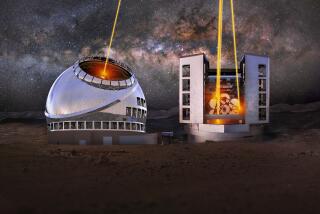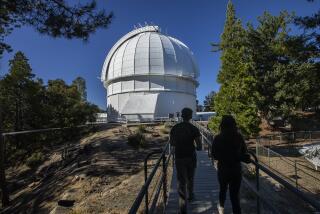Galaxy of High-Tech Instruments Joined in Hubble Space Telescope
- Share via
KENNEDY SPACE CENTER, Fla. — The Hubble Space Telescope, launched Tuesday aboard the space shuttle Discovery, is far more than a single telescope.
It is five, some say six, telescopes wrapped into one.
The telescope has five primary instruments, each the size of a telephone booth, designed to study the universe in different ways. In addition, the telescope’s guidance system is so precise it will keep the Hubble fixed on distant pinpoints of light while zipping around the Earth at 25,000 m.p.h. The guidance system will permit scientists to make exacting measurements of the distance to many objects, for example, and possibly even detect the existence of other planetary systems by measuring tiny changes in the position of distant stars.
These are referred to as the Hubble’s first generation of instruments because they are designed to be replaced in a few years with updated equipment. The Hubble is the only satellite designed to be continually serviced and improved during its life expectancy of 15 to 30 years.
The telescope’s instruments include:
Wide Field/Planetary Camera--This is probably the telescope’s best-known instrument because it will produce electronic images--photos, if you will--that can be appreciated by the taxpayers who are paying the $2-billion price for the Hubble.
However, its name is a bit misleading. It will not image wide areas of the universe, because that chore is better accomplished by ground-based telescopes that can study huge swaths of the nighttime sky. But it will have a wider field of view than the other instruments aboard the Hubble, allowing scientists to make multiple images of complete galaxies instead of just points of light.
And the planetary camera will not look for other planets around other stars. It will instead concentrate on planets in this solar system, providing images comparable to those returned by the Voyager spacecraft on its recent visit to Neptune. The Hubble will not provide quite the resolution of Voyager, but it has one distinct advantage--staying power. The Voyager produced “snapshots” of four outer planets as it zipped past them on its grand tour of the solar system. The Hubble will be able to return again and again to the same targets, providing images that will show such things as how the planets change during different seasons. The wide field camera will use 50 filters to sort radiation into different spectral bands, allowing scientists to determine the chemical composition of the targets. And in just one-tenth of a second it will be able to take a picture of a star 10,000 times too faint to be seen with the naked eye. For even dimmer objects, the telescope can remain fixed on a distant target for more than an hour, capturing images of objects 40 times fainter than routinely photographed with large ground-based telescopes.
The dimmer objects are particularly fascinating to scientists because they will be seen as they were billions of years ago, not as they are today, because it has taken the light that long to reach Earth.
Faint Object Camera--This instrument takes over where the wide field camera leaves off, and it is designed to photograph objects farther away than any telescope has ever seen before. The wide field camera can cover a larger area, but the faint object camera has higher resolution and is thus better suited for more distant objects.
This instrument will use an electronic intensifier to create an image in the camera that is 100,000 times brighter than the image focused by the telescope mirror. Because of its high resolution, this instrument will be able to separate stars that now appear as a single pinpoint of light in ground-based telescopes, and it will be particularly useful in studying fine details around the centers of active galaxies and in searching for evidence of black holes, objects so dense that even light cannot escape their gravity.
The Faint Object Camera will also operate in ultraviolet wavelengths, which do not reach ground-based telescopes because of Earth’s atmosphere, giving scientists a unique opportunity to study the universe in ways that cannot be done from the ground.
The camera will also be able to block out very bright light in order to study dimmer objects that would otherwise be overwhelmed by brighter companions.
Faint Object Spectrograph--By studying light from celestial objects, astronomers can determine what the objects are made of because different wavelengths indicate the presence of various chemical elements. The atoms of an element also emit or absorb light depending on such things as temperature and pressure, so scientists can use the light any object emits to learn whether it is hot or cold, how dense it is and its chemical composition.
Other studies can reveal how far away it is and its velocity relative to Earth. Because of its ability to measure distances to very dim objects, the Faint Object Spectrograph should help scientists address some of the most important questions about the universe.
“Distance is connected to two very fundamental questions, how big is the universe, which we don’t know, and how old is the universe,” said Richard Harms of the Applied Research Corp. in San Diego, the principal investigator.
Goddard High Resolution Spectrograph--This instrument is similar to the Faint Object Spectrograph except it operates at ultraviolet wavelengths.
Since it is blind to visible light, the spectrograph will be able to look at ultraviolet emissions from very bright stars and it will be able to study objects 1,000 times dimmer than those previously observed by instruments in space.
Astronomer John Brandt of the University of Colorado, the principal investigator, believes that this instrument may help resolve a burning astronomical controversy because it should reveal the chemical composition of comets. “We should be able to test the speculation that comets may be responsible for the water on Earth,” Brandt said in an interview.
High Speed Photometer--This is billed as the simplest instrument on the Hubble.
“It simply measures light,” said Robert Bless of the University of Wisconsin, the principal investigator. It is similar to the light meter on a camera, except it measures the light thousands of times every second to detect subtle changes.
This instrument will make it possible to study objects that rotate rapidly or flicker, perhaps even black holes.
No one has ever proved the existence of black holes, which many scientists believe lurk at the heart of every galaxy.
Fine Guidance Sensors--Although not listed as an instrument, the sensors are designed to keep the telescope focused on a pinpoint of light for hours at a time, and thus are so precise that they will yield many astronomical measurements.
The type of precision measurement used by the Hubble, called astrometry, could tell scientists if a distant star wobbles slightly, indicating that it is influenced by the gravitational field of a companion, possibly a planet.
NASA’S HUBBLE SPACE TELESCOPE The Hubble’s 380-mile-high orbit puts it above the atmospheric turbulence that causes the stars to twinkle in Earth-based telescopes. The Space Telescope will able to “see” wavelenghts of light which cannot penetrate Earth’s atmosphere. Scattered light (which makes the sky look blue on Earth) will be almost eliminated, allowing the telescope to observe faint objects more easily. Inside the Space Telescope Light enters the eight-foot aperture, is reflected off of the primary and secondary mirrors, enters a hole in the center of the primary mirror, and is finally directed to the scientific instruments in he rear of the telescope. Scientific instruments A. High-resolution spectrograph B. High-speed photometer C. Faint-object spectrograph D. Faint-object camera Overall length: 42.5 ft. Diameter: 14.0 ft. Weight: 24,250 lbs. Orbital period: 94 min. Mission duration: 15 years Sources: Lockheed Missiles & Space Co., NASA, Sky & Telescope Magazine, Aviation Week & Space Technology magazine.






